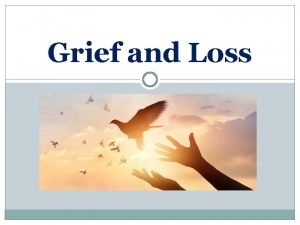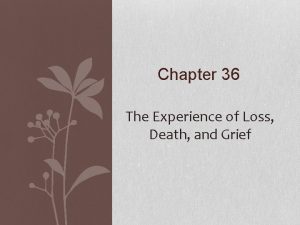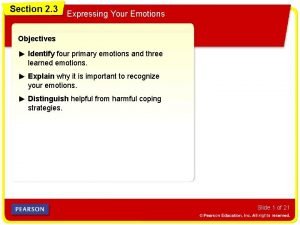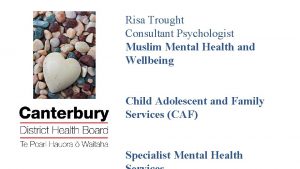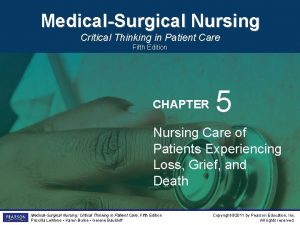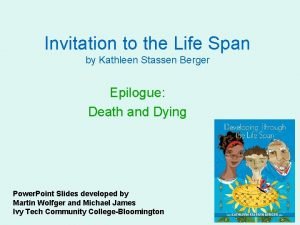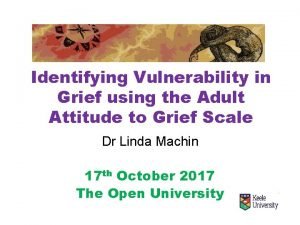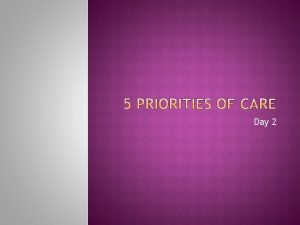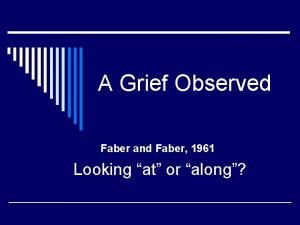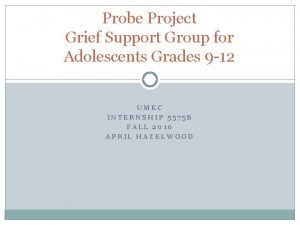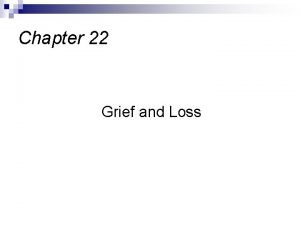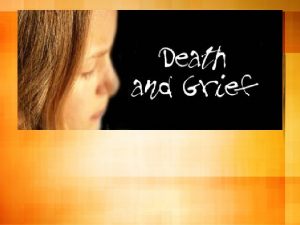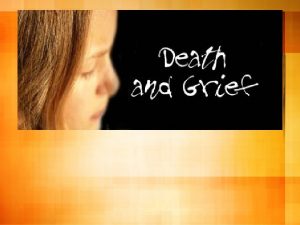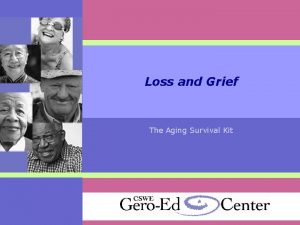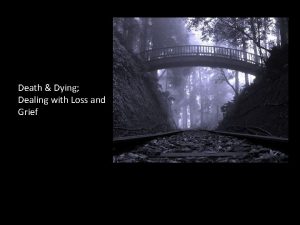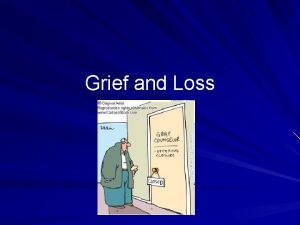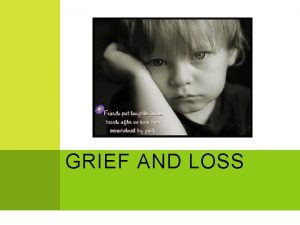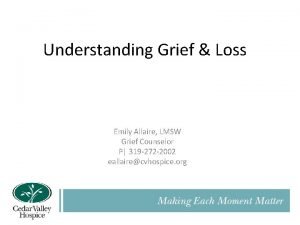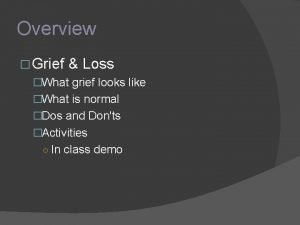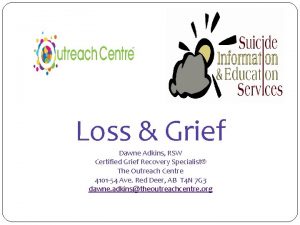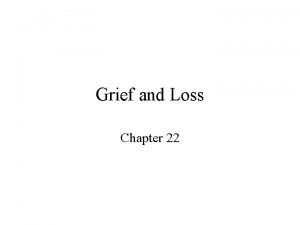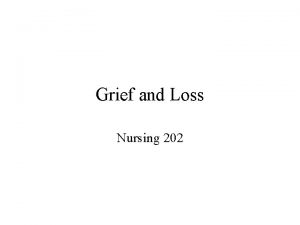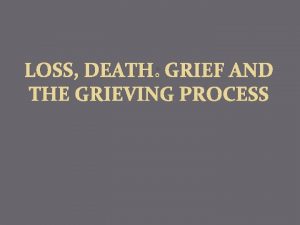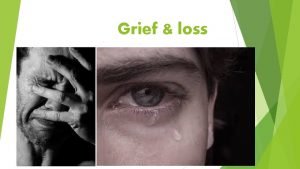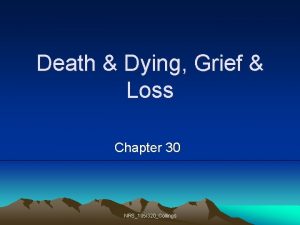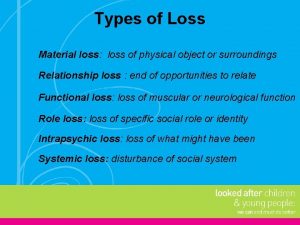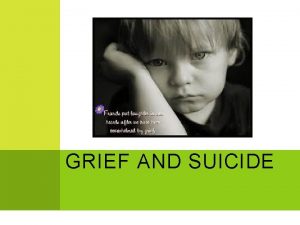Grief and Loss Grief is a natural response






















- Slides: 22

Grief and Loss


Grief is a natural response to loss. It’s the emotional suffering we feel when something or someone we love is taken away. During the Coronavirus Pandemic we all experienced loss and grief not only because loved ones were taken away from us (either due to death or social distancing), but we also experienced the loss of our every day lives and routines. Often, the pain of loss can feel overwhelming. We may experience all kinds of difficult and unexpected emotions, from shock or anger to disbelief, guilt, and profound sadness. The pain of grief can also disrupt our physical health, making it difficult to sleep, eat, or even think straight. These are normal reactions to loss—and the more significant the loss, the more intense our grief will be. The Lockdown happened quickly and the limitations were severe and almost universal; we all had to deal with this profound loss of freedom and normality as we had known it, on top of the physical loss of people around us. Coping with that level of loss is one of life’s biggest challenges. Understanding the process of grief and the effect it has on our physical, mental and emotional well-being is the first step to healing and moving forward. The journey through grief is personal; however, we can walk alongside each other and support one another with kindness, humility, patience and self-awareness.

Myths and Facts about grief

Grief �Myth: The pain will go away faster if you ignore it �Fact: Trying to ignore your pain or keep it from surfacing will only make it worse in the long run. For real healing, it is necessary to face your grief and actively deal with it.

Grief �Myth: It’s important to “be strong” in the face of loss. �Fact: Feeling sad, frightened, or lonely is a normal reaction to loss. Crying doesn’t mean you are weak. You don’t need to “protect” your family or friends by putting on a brave front. Showing your true feelings can help them and you.

Grief �Myth: If you don’t cry, it means you aren’t sorry about the loss. �Fact: Crying is a normal response to sadness, but it’s not the only one. Those who don’t cry may feel the pain just as deeply as others. They may simply have other ways of showing it.

Grief �Myth: Grieving should last about a year. �Fact: There is no specific time frame for grieving. How long it takes differs from person to person.

Grief �Myth: Moving on with your life means forgetting about your loss. �Fact: Moving on means you’ve accepted your loss— but that’s not the same as forgetting. You can move on with your life and keep the memory of someone or something you lost as an important part of you. In fact, as we move through life, these memories can become more and more integral to defining the people we are.

Grief �Face your feelings �Express your feelings in a tangible and creative way �Try to maintain your hobbies and interests �Don’t let anyone tell you how to feel and don’t tell yourself how to feel either �Plan ahead for grief triggers �Look after your physical health �Turn to family, friends, teachers and other trusted adults for comfort and guidance

When to seek help �Feel like life isn’t worth living �Wish you had died with your loved one �Blame yourself for the loss or failing to prevent it �Feel numb and disconnected from others for more than a few weeks �Are having difficulty trusting others since your loss �Are unable to perform your normal daily activities

Grief and Loss Models � Many professionals have been researching how people react to loss and have come up with models which map the grieving process � Each model explains how people respond to grief (in stages, or through tasks or in phases) and provides some useful guidance on how to move forward � The models can be seen as complementary to each other; we can choose what we like from each one and apply it to our own lives and grieving process � Knowing that grief is a universal, natural response to loss, helps us understand that experiencing negative feelings is normal and that these feelings will go away or become less painful with time

The Kübler-Ross Model �One of the most well-known models on how to deal with grief is the Kübler-Ross Model �According to it, people go through five emotional stages when they are grieving: 1. Denial- This can’t be happening to me! 2. Anger- Why is this happening? Who is to blame? 3. Bargaining- Make this not happen, and in return I will. . . 4. Depression- I’m too sad to do anything. 5. Acceptance- I’m at peace with what happened.



William Worden – Tasks of Mourning �Task 1 – To accept the reality of the loss. Often a sense of unreality when someone dies as our minds struggle to process the enormity of what has happened. On a rational level you may know they have died but on an emotional level you can’t accept it. What can I do? It takes time to shift towards talking about the person in the past tense but this shift does need to happen in order to accept they are dead and will not return.

William Worden – Tasks of Mourning �Task 2 – To process the pain of grief Range of emotions including pain, sadness, guilt, anger and helplessness following bereavement and these need to be experienced as a part of the mourning process. Many people try to block out and avoid these intense and unpleasant feelings. Distracting yourself with work, turning to alcohol or drugs, stopping yourself from crying, pretending it doesn’t matter are all ways of avoiding the pain. However the grief is likely to resurface at times you don’t expect it and if unexpressed can lead to emotional difficulties in the future. What can I do? Allow yourself to feel what you are feeling. Find ways to express your emotions through writing, drawing or music; talk to friends and family or a counsellor at some point in the grief process, particularly if you are finding it hard to process the pain on your own a few months or years on from the death.

William Worden – Tasks of Mourning �Task 3 – To adjust to a world without the deceased Losing a loved one requires us to make many external, internal and emotional adjustments. The death may affect our sense of self and the way we see the world. It takes time to process and adjust to these changes. What can I do? What are the losses and gains inherent in this death? For example, an older woman whose husband dies after a long illness may find themselves with greater freedom to take up new activities, to travel or to spend more time with grandchildren.

William Worden – Tasks of Mourning �Task 4 – To find an enduring connection with the deceased in the midst of embarking on a new life You do not need to forget about the person who has died. They will always be an important part of your life and no one can take that away. Finding a way to remain emotionally connected to deceased person can actually help you move forward into a new life without them. What can I do? What rituals around remembrance will help? make a photo album of the person’s life that they can look back on in years to come, or memory box; photos on display; visiting the grave can be ways to connect with the person’s memory.

The Dual Process Model �According to this model, we experience grief as a dialogue between pain and hope: sometimes we think and feel our loss and other times we focus on restoring our lives back to normal

Personal response �While all these models help us understand grief and our general responses to loss, we must remember that grieving is a personal process: only we know exactly how we feel and how much time we need to recover from a loss �Sharing our thoughts and feelings of the Lockdown experience with family, friends and the wider community is a powerful way to move forward and embrace growth and hope in our lives

Moving forward as a school community � A wall of remembrance of the people we have lost and the events/activities we have missed out on � Create a tree with leaves representing the learning, reflecting and growing moments we have experienced � Create (or decide on) the Lockdown Remembrance flower/plant (like the poppy for Remembrance Day)- what qualities will it have that reflect this period in our lives? � Create a treasure box with precious advice/thoughts and nuggets of wisdom should we find ourselves in a similar situation in the future � Create a piece of art in any medium to express our thoughts and feelings (individually, in small friendship groups, in form groups or year groups)
 Wordens task of mourning
Wordens task of mourning Chapter 4 lesson 3 coping with loss and grief
Chapter 4 lesson 3 coping with loss and grief Chapter 36 loss and grief
Chapter 36 loss and grief Stages of grief and loss
Stages of grief and loss Natural response and forced response
Natural response and forced response Natural response and forced response example
Natural response and forced response example Unit cost meaning
Unit cost meaning Primary immune response and secondary immune response
Primary immune response and secondary immune response The three learned emotions are grief shame and
The three learned emotions are grief shame and Natural income
Natural income First order rc
First order rc Children grief
Children grief Engels model of grief
Engels model of grief Absent greif
Absent greif Grief scale for adults
Grief scale for adults Lip corner depressor
Lip corner depressor Grief is like an earthquake
Grief is like an earthquake Engels model of grief
Engels model of grief Grief wheel
Grief wheel A grief observed chapter 1
A grief observed chapter 1 Ice breakers for grief support groups
Ice breakers for grief support groups Proprietary grief
Proprietary grief Ambiguous loss definition
Ambiguous loss definition
